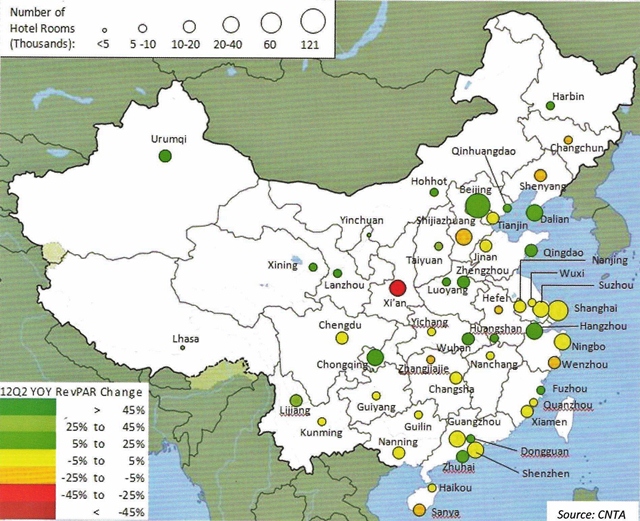(Written by G. Angelini for the 2011 Hotel Yearbook Publication)
FAR FROM BEING JUST THE «FLAVOR OF THE MONTH,» DEVELOPING NEW HOTEL PROJECTS IN CHINA, AND TO SOME EXTENT IN INDIA, CAN BE REFERRED TO AS THE «FLAVOR OF THE PAST TEN YEARS,» WRITES GIOVANNI ANGELINI, RETIRED CEO OF SHANGRI-LA HOTELS & RESORTS AND PRESENTLY CHIEF EXECUTIVE OF ANGELINI HOSPITALITY IN HONG KONG. WITH OVER ONE THOUSAND NEW HOTEL PROJECTS ANTICIPATED TO OPEN DURING THE NEXT THREE TO FOUR YEARS IN ASIA, THE PRESENT DEVELOPMENT TRENDS ARE EXPECTED TO CONTINUE. HE SHARES HIS ADVICE HERE FOR 2011 AND BEYOND.
It would be wise for new developments/investors to take into consideration a number of very important factors in China, India, and other Asian markets in the future :
Too far ahead of demand
Investing in those countries, China in particular, should generate attractive returns in the long term but in the shorter-to-medium term, there are serious concerns within the industry that hotels are developed too far ahead in several regional markets, especially as the present buying/spending power from the local consumer – particularly the middle class – has not yet reached a level to sustain those new up-scale hotel products.
In some markets, developers have to accept the fact that those new hotel facilities will require additional funds to cover the initial operating losses and the related financing costs for a number of years after opening for business.
For ROI go mid-scale
In general, there is an oversupply of high-end hotels within most of the Chinese, and some other Asian, hotel markets. As per the current trend, there is stronger demand from the regional travelers for mid-scale hotel products, for which there is less supply, and there are no doubts that the new high-end hotels will not generate satisfactory ROI for their investors, especially with the constant and rapid increase of development costs, in particular land and construction. It is clear that if a developer is looking at the ROI, an efficient and comfortable mid-scale hotel product will definitely generate higher financial returns.
What’s the developer’s objective?
We cannot get away from the fact that in some instances within Asia, hotels are built for different reasons and purposes. The most commonly seen reason to develop a high-end hotel is as part of a new/large multi-use complex, where the hotel normally provides «prestige/status» with the specific objective of driving up the value of the real estate within the new complex. It is clear that in those cases, the hotel market and the customers/consumers are not taken into consideration. This is a concern for the industry, as those hotels are the first one to apply pricing inconsistency (undercuts) in order to attract volume/occupancy.
Also, we cannot avoid that in a number of cases, the objective of the development/investor is to «build for sale» (early exit strategy) as soon as there is profit to be made. Quick profit is very attractive to many, and again, in those cases the market, the customers/consumers and, in some instances, the employees are not taken into consideration. The bona fide developer must take into consideration the above unhealthy development trends within the industry.
Successful hotels are the ones that are built and operated for the long term, and the ones that continue to add value to their customers, and have a durable strategy of maintaining competitive advantage.
«Build it and they will come» no longer applies
Market and spending trends are changing very fast, and the explosion of new technologies must be considered in designing the new hotel products. Asian/regional developers have to spend more time assessing the markets and doing extensive feasibility studies/surveys before embarking on a new hotel project, regardless of the geographical location. New products should be established to meet the preferences of travelers and the needs/expectations of local consumers.
«Sleep and Food»
This is what hotels are selling to their customers. The developer must fully understand this and accept the fact that to do this well requires knowledge of the market, the availability and quality of the labor and practical designs in order to create an efficient and functional hotel product, making it easy for the customer to identify and buy it, plus the ability to compete in any market situation. Asia has seen a number of «emotionally driven» developers/buyers, regardless of the market situation. This has not been positive for the industry, as it created pricing and standards inconsistencies. Looking at 2011, stricter discipline will definitely help the new hotel developers and the industry in general.
Focus on the customer
The need and the comfort of customers must be taken into consideration from the very beginning of the development process. This starts with a clear vision and objective, which must then be reflected in the planning, the design and in the final operations of the hotel project. Architects and designers must be properly briefed and guided to avoid extravagant and impractical ideas and designs. It is said that a designer’s dream is a housekeeper’s nightmare.» Customers want efficiency, comfort and uncomplicated products and systems.
Who is coming and why
The present and anticipated market trends are to be the driving factors when it comes to planning a new hotel. It is never too early to address why the customer will eventually choose this particular new hotel once it is in business. The geographical source of the expected customers, the segmentation, the ever-changing distribution and booking systems and practices, individual travelers vs. declining tour groups, the profile of meeting/event participants – all these factors form the basis of determining the required hotel facilities, such as the size and look of the lobby, the mix of beds (twin vs. king size), the function/meeting facilities with the latest in video conferencing, the concept of the restaurants and bars, the importance of the wellness center, the private dining rooms within the restaurants, parking facilities, the latest in technology systems making it easier for the client to book and for the operator to run the hotel, and so on. The new hotel must have the ability to make future changes in line with market trends and evolution of the industry itself, without major physical disturbances or changes.
Don’t forget the staff
At the planning and design stages, a smart developer must also allocate comfortable space and provision for the latest facilities for the internal customers: the employees. It is a fact that great hotels are made by the employees, not by extravagant architecture or crystal chandeliers. This must be embraced in full by the developers. Unfortunately, in the past many hotels have not given the necessary attention to employees’ facilities or adequate back-of-the-house space. Special attention must be given to training rooms, dining area, rest and recreation, and employee activities. In some locations, it is also necessary to provide employee housing, and the new hotels must get away from the cold and unfriendly dormitories that we have seen in the past.
As in other parts of the world, Asia will also encounter serious shortages of skilled labor and difficulties in retaining good people. So it is never too early to establish a competitive compensation package and employee welfare package with the objective of minimizing employee turnover and having a fully engaged team.
CSR, LEED, carbon emissions,…
The hotel industry within the region has made good progress in the Corporate Social Responsibility (CSR) arena during the past several years. However, a lot remains to be done, both at the community level and in terms of improved sustainability. This is true for most of the hotels, but non-branded properties in particular. The hotel industry could practice less soft public relations but more concrete actions in this important area.
As a guide for new developments and for major renovations, a worthwhile approach would be to strive for some internationally recognized certification like LEED (Gold). This would encourage the implementation of practical, measurable solutions at the design stage of the project, especially in eco-design, building insulation/envelope, soundproofing/acoustics, health and safety, internal and external traffic flow, efficiency of vertical transportation, energy savings, water efficiency, recycling, reduction of CO2 emissions, use of natural lighting, and many others.
Of course, the LEED Certification comes at a cost. However, the return on the investment is achieved within a few short years (three or four), and the hotels will definitely achieve substantial savings and operational efficiency in the medium to long term. This will be reflected in the performance and profitability of the new projects.

